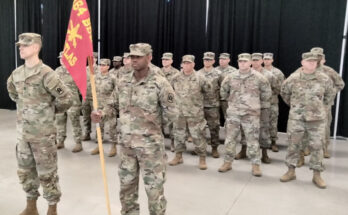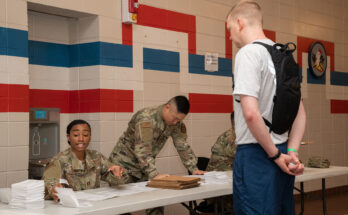United States Navy SEALs Recruitment: The United States Navy SEALs are among the most elite special forces units globally. Their legacy of stealth, discipline, and precision has been built over decades of challenging missions and rigorous training.
However, the path to becoming a Navy SEAL is not straightforward; it is carved through demanding selection processes and specialized training programs.
In this article, we delve deep into the United States Navy SEALs Recruitment Programs.
General Criteria for Enlistment:
- Age: Candidates must be between the ages of 17 and 28. Exceptions are made for candidates with prior military service.
- Citizenship: Only U.S. citizens or those who hold an Alien Registration Card are eligible.
- Education: A high school diploma or equivalent is required. Some roles may require additional educational qualifications.
- Physical Fitness: Candidates must meet rigorous physical fitness standards, which include specific requirements for swimming, push-ups, sit-ups, and running.
- Vision: Eyesight must be correctable to 20/25, and color blindness can disqualify a candidate.
- Legal Background: Candidates should have no felony convictions and must pass a thorough background check.
Key Stages in the Recruitment Process:
- ASVAB Test: All potential recruits begin with the Armed Services Vocational Aptitude Battery (ASVAB) test to determine eligibility for the SEAL program.
- Physical Screening Test (PST): This is a rigorous physical assessment that tests swimming, push-ups, sit-ups, pull-ups, and a timed run.
- Naval Special Warfare Preparatory School: After passing the PST, candidates attend a preparatory school in Great Lakes, Illinois, designed to prepare them for the challenges ahead.
- Basic Underwater Demolition/SEAL (BUD/S) Training: This intense six-month training regime is notorious for its “Hell Week,” pushing candidates to their physical and mental limits.
- Parachute Jump School: Candidates learn basic airborne techniques and military free fall.
- SEAL Qualification Training (SQT): This is the final stage where candidates receive comprehensive training in combat skills, including weapons, demolition, and reconnaissance.
Successfully navigating the SEAL recruitment process requires a combination of physical stamina, mental resilience, and unwavering dedication. It ensures that the U.S. Navy SEALs maintain their reputation as one of the most formidable special operations forces globally.
Basic Underwater Demolition/SEAL (BUD/S) Training: An In-Depth Look
The Basic Underwater Demolition/SEAL (BUD/S) training is the cornerstone program for those aspiring to join the elite ranks of the Navy SEALs. Recognized worldwide, this training program is not just about physical prowess, but also the mental fortitude required to become one of the world’s best.
Physical Challenges in BUD/S Training
- Hell Week: Often considered the toughest part of BUD/S, Hell Week is a five-and-a-half-day stretch where candidates get a mere four hours of sleep total. They undergo continuous physical tasks, from long-distance runs in the sand to paddling rubber boats through challenging waters.
- Underwater Drills: Candidates must prove their ability to stay calm under pressure—literally. Training includes timed underwater swims and complex dive missions. There’s also the dreaded “drown-proofing” test, where candidates’ hands and feet are bound, yet they must still float, swim, and retrieve objects from the pool’s bottom.
- Obstacle Courses: These are designed not only to test a candidate’s physical agility but also their determination and resilience. Featuring high walls, muddy trenches, and rope climbs, these courses push candidates to their limits.
Mental Challenges in BUD/S Training
- Sleep Deprivation: As part of their training, SEAL candidates often operate on minimal sleep. This not only tests their physical endurance but challenges their cognitive functions, requiring them to think clearly and make decisions while exhausted.
- Stress Simulations: Candidates undergo various simulations that replicate real-life combat and rescue situations. These high-pressure drills ensure that they can handle stress, make swift decisions, and operate effectively in real-world scenarios.
- Teamwork and Leadership: Every exercise in BUD/S underscores the importance of teamwork. Candidates quickly learn that individual achievement means little without collective success. They are constantly evaluated on their leadership and ability to collaborate under pressure.
However, BUD/S training is a true test of one’s physical and mental limits. It meticulously prepares SEAL candidates for the challenges they will face in their careers, ensuring that only the best and the most dedicated join the ranks of the Navy SEALs.
SEAL Qualification Training (SQT)
After successfully navigating the challenges of BUD/S, prospective SEALs progress to SEAL Qualification Training (SQT). This stage is pivotal in a SEAL’s journey, dedicated to refining the specialized skills they’ll need in real-world operations.
What’s Covered in SQT? Here are the primary areas of focus:
- Weapons Training: Mastery in weapon handling is paramount. SQT provides in-depth training on a variety of firearms, ensuring SEALs are proficient in both close-quarters and long-range engagements.
- Cold-Weather Survival: SEALs can be deployed anywhere, including freezing environments. SQT emphasizes survival techniques in cold conditions, teaching candidates how to navigate, sustain, and effectively operate in icy terrains.
- Advanced Combat Tactics: Moving beyond basic combat strategies, SQT dives into sophisticated tactics. SEALs learn to operate in diverse scenarios, coordinating with teams, analyzing threats, and executing missions flawlessly.
SEAL Qualification Training ensures that by its culmination, each SEAL is more than just physically fit; they’re adept, knowledgeable, and ready for any challenge that comes their way. The emphasis on weapons, survival, and tactics guarantees they’re not only equipped for their missions but are also among the best in their field.
The Crucial Role of Mentoring in United States Navy SEALs Recruitment
In the elite world of the United States Navy SEALs, mentoring plays an indispensable role in shaping the future warriors of the nation. It isn’t just about physical prowess; the psychological and emotional resilience required to be a SEAL is equally vital, and this is where the guidance of seasoned SEALs becomes paramount.
How experienced SEALs mentor and guide potential recruits:
Experienced SEALs, often with numerous missions under their belts, take budding recruits under their wings. Their primary objective isn’t just to prepare them for the rigorous physical tests ahead but to infuse in them the ethos and values of a SEAL. They share personal anecdotes, strategies, and even failures to provide a realistic picture of what lies ahead. By doing so, they ensure potential recruits gain not just the skills, but also the mindset needed to succeed in the harshest of conditions.
The significance of mentorship in preparing candidates for the challenges ahead:
Mentorship in the SEALs isn’t just a formality; it’s a legacy. The wisdom passed down from seasoned SEALs to novices is invaluable. This mentoring ensures that candidates are not just physically prepared, but also mentally fortified for the challenges ahead. They learn about teamwork, the importance of trust, and the weight of responsibility. It’s this mentorship that transforms raw talent into disciplined SEAL warriors, ready to defend their nation at all costs.
This nurturing environment fostered by mentorship also aids in identifying potential areas of improvement, ensuring that candidates are given every opportunity to succeed. In a realm where mistakes can cost lives, the guidance provided by experienced SEALs ensures that the next generation is as prepared as they can be for the daunting journey ahead.
However, while physical training is a significant part of SEAL recruitment, it is the mentorship provided by experienced SEALs that truly shapes and prepares a recruit for the demands of the role. This mentor-mentee relationship is the bedrock on which the SEAL community thrives, guaranteeing the continued excellence of this elite fighting force.
Special Recruitment Programs and Opportunities
1. Naval Special Warfare Preparatory School (NSWPS):
The Naval Special Warfare Preparatory School is a specialized training program designed to prepare candidates for the demanding requirements of the Naval Special Warfare community. Candidates undergo rigorous physical and mental training, emphasizing team-building, endurance, and aquatic competence. Completing the NSWPS not only demonstrates a recruit’s dedication and resilience but also significantly improves their chances of success in subsequent training phases.
Key points to consider:
- Intensive aquatic and physical training sessions.
- Enhances team-building and leadership skills.
- Prepares candidates for more advanced Naval Special Warfare programs.
2. SEAL Officer Assessment and Selection (SOAS) Program:
The SOAS program stands as a crucial step for those aiming to become officers in the Navy SEALs. Through a combination of leadership assessments, physical tests, and mental evaluations, this program identifies individuals who showcase the potential and determination to lead in the elite SEAL teams. The selection process is stringent, ensuring only the finest candidates proceed.
Key points to consider:
- Evaluates leadership, physical prowess, and mental fortitude.
- Highly selective, designed to identify future Navy SEAL officers.
- Offers in-depth exposure to the SEAL community and its expectations.
3. The Role of the Delayed Entry Program (DEP) in Recruitment:
The Delayed Entry Program serves as a bridge between initial recruitment and formal military training. Through DEP, recruits can secure their place in the military while still finishing up personal commitments, such as school. This program not only provides recruits with preparatory resources and insights about their chosen career path but also ensures the military retains promising candidates.
Key points to consider:
- Offers a smooth transition between recruitment and formal training.
- Allows recruits to wrap up personal commitments before full-time service.
- Provides preliminary insights and resources related to military life.
Incorporating these specialized programs into one’s career path can significantly elevate the prospects of serving in the esteemed Naval Special Warfare community. Ensure you understand each program’s requirements and expectations to maximize your success.
Women in the SEALs
The inclusion and participation of women in the U.S. Navy SEALs is a topic of great significance. Over the years, there’s been an evolving dynamic, with shifts in policy and perception playing crucial roles.
A Brief History of Women’s Roles in the SEALs:
Historically, the SEALs, like many military special operations units, were male-dominated. Women were primarily relegated to support roles, with no direct involvement in frontline combat operations. However, as the broader military started opening more roles to women in the late 20th and early 21st century, the conversation around their inclusion in the SEALs gained momentum. Advocates argued that gender shouldn’t limit anyone with the necessary skills and determination. The pivotal moment came in 2015 when the U.S. Department of Defense announced that all military combat roles, including those in the SEALs, would be open to women. This move paved the way for a more inclusive SEALs program, although the physically demanding nature of SEAL training ensures that all candidates, regardless of gender, are held to the highest standards.
Current Status and Opportunities for Female Candidates:
As of today, the doors to the SEALs are open to women. Those who meet the stringent requirements and can withstand the grueling Basic Underwater Demolition/SEAL (BUD/S) training have an equal opportunity to become a Navy SEAL. While the number of women who have attempted and successfully passed BUD/S remains relatively low compared to men, their presence signifies a shift towards a more inclusive military. The U.S. Navy actively encourages female candidates to apply, emphasizing that talent, determination, and grit know no gender.
For women considering a career in the SEALs, the message is clear: the opportunities are there, waiting for those with the passion and perseverance to seize them.
Physical and Psychological Requirements for Potential SEAL Recruits
When considering a career as a Navy SEAL, it’s essential to be aware of both the physical and psychological requirements. These standards ensure that every recruit possesses the endurance, strength, and mental resilience necessary for the grueling challenges they will face.
1. Detailed Breakdown of Fitness Standards and Benchmarks:
- Swimming: Potential recruits should be able to swim 500 yards in under 12.5 minutes. This is tested using combat sidestroke or breaststroke techniques.
- Push-ups: In a time frame of 2 minutes, candidates should be able to perform at least 50 push-ups, although higher numbers demonstrate superior strength and endurance.
- Sit-ups: A minimum of 50 sit-ups should be completed within 2 minutes.
- Pull-ups: No time limit is imposed, but a recruit should be able to do a minimum of 10 consecutive pull-ups without touching the ground.
- Running: A 1.5-mile run should be completed in boots and long pants in under 10.5 minutes.
Meeting these benchmarks is just the beginning. To succeed in training and operations, recruits will often need to surpass these minimum requirements.
2. Psychological Traits Desired in Potential SEALs:
- Resilience: SEAL operations can be challenging and demanding. It’s crucial for recruits to bounce back from setbacks and keep pushing forward, even in the face of adversity.
- Mental Toughness: In addition to physical endurance, a SEAL must possess the mental fortitude to cope with high-stress situations without breaking down.
- Adaptability: Missions often don’t go as planned. A SEAL’s ability to adapt to changing circumstances, think on their feet, and improvise solutions is invaluable.
- Teamwork: While individual strength is essential, SEALs operate as a unit. Team cohesion and the ability to work effectively with others are paramount.
- Determination: The training and operations SEALs undergo are among the most challenging in the military. An unwavering commitment to the mission and the will to persevere is a must.
However, becoming a Navy SEAL requires more than just physical strength. While meeting the fitness standards is vital, the psychological traits play an equally, if not more, significant role in determining a recruit’s success in the elite world of the Navy SEALs.
Challenges and Drop-out Rates of United States Navy SEALs
Here, we shed light on the challenges faced by these aspirants and the support provided by the Navy to those who don’t complete the program.
Realities of the Recruitment Process: Why Many Don’t Make the Cut
- Physical Demands: The Basic Underwater Demolition/SEAL (BUD/S) training is physically exhausting. From Hell Week, which involves five days of non-stop training with a mere four hours of sleep, to various underwater drills and extreme physical tests, many candidates drop out due to the sheer physical toll.
- Mental Resilience: Beyond the physical challenges, the mental strain of SEAL training is profound. Candidates must possess unwavering determination, the ability to stay calm under immense pressure, and unparalleled endurance to keep pushing forward when every fiber of their being is telling them to quit.
- Skills Proficiency: Not every drop-out is due to physical or mental endurance. Some candidates might not achieve the necessary proficiency in critical skills such as diving, parachuting, or combat strategy, which are essential for a Navy SEAL.
How the Navy Supports Those Who Don’t Complete the Program
While the dropout rates are high, the Navy ensures that candidates who don’t become SEALs still find a meaningful path within the organization:
- Reassignment Opportunities: Those who don’t complete BUD/S or subsequent SEAL training can be reassigned to other roles within the Navy, utilizing their unique strengths and skills.
- Counseling and Mental Health: Recognizing the immense mental pressure of SEAL training, the Navy offers counseling services to those who drop out, ensuring their mental well-being is taken care of.
- Future Attempts: Depending on individual circumstances, some candidates may be given another chance to go through the SEAL training at a later date.
However, while the path to becoming a Navy SEAL is paved with immense challenges, the Navy ensures that every candidate, whether they earn the SEAL trident or not, is treated with respect and given opportunities to excel in other capacities.
Conclusion
In wrapping up, the importance of the United States Navy SEALs’ recruitment cannot be overstated. This elite group represents the pinnacle of military precision, resilience, and dedication. As our global landscape evolves and presents new challenges, the need for dedicated individuals willing to go above and beyond remains paramount.
Joining the ranks of the Navy SEALs is not just about becoming part of an esteemed unit; it’s about committing to a higher calling, safeguarding global peace, and ensuring our nation’s security. We must continuously encourage and support those with the passion and tenacity to take on this vital role.
Let’s champion the future of the SEALs by understanding and emphasizing their ongoing need for exceptional recruits.



